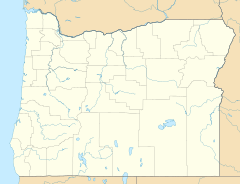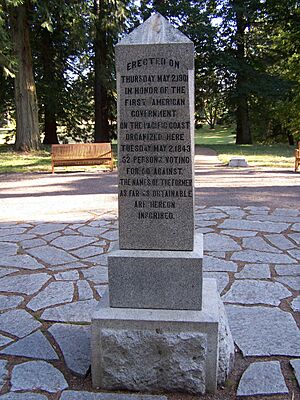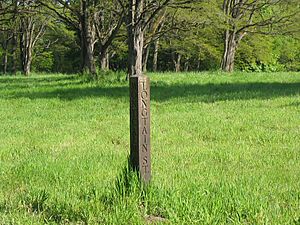Champoeg, Oregon facts for kids
Quick facts for kids
Champoeg, Oregon
|
|
|---|---|
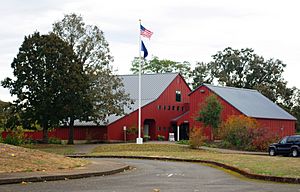
Museum at the state heritage area
|
|
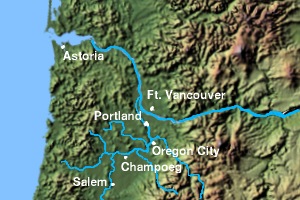
Location near neighboring cities
|
|
| Country | United States |
| State | Oregon |
| County | Marion |
| Time zone | UTC-8 (Pacific (PST)) |
| • Summer (DST) | UTC-7 (PDT) |
| ZIP code |
97137
|
| Area codes | 503 and 971 |
Champoeg (pronounced sham-POO-ee) is a place in Oregon that used to be a busy town. Today, it is known as a ghost town, meaning most of its buildings are gone. In the early 1840s, Champoeg was a very important settlement in the Willamette Valley. It was located between Oregon City and Salem. This historic spot was where the first temporary government for the Oregon Country was created.
The original town site is on the south side of the Willamette River in northern Marion County. It is part of an area called French Prairie, about 5 miles (8 km) southeast of Newberg. Now, the area is protected as the Champoeg State Heritage Area, which is an Oregon state park. Inside this heritage area, you can also find the Champoeg State Park Historic Archeological District. The name "Champoeg" comes from a Kalapuyan word that likely referred to an edible root called yampa.
Contents
Champoeg's Early History
Champoeg is famous for a series of important meetings held there in the 1840s. These meetings helped shape the future of the Oregon Country.
The First Meetings and Wolf Problems
On February 7, 1841, settlers from the Willamette Valley gathered in Champoeg for the first time. They chose Jason Lee, a missionary, to lead their discussions. One of their main concerns was how to deal with wolves that were bothering their settlements. These "Wolf Meetings" were the first steps toward creating rules and laws for the community.
Creating a Government for Oregon
In the mid-1840s, there was a big question about who owned the Oregon Country. Both the United States and the United Kingdom claimed it. On May 2, 1843, another crucial meeting took place in Champoeg. The settlers voted on whether to create a temporary government. The idea passed by a very close vote: 52 people said yes, and 50 said no!
A group of nine representatives was then chosen to set up this new government. Champoeg was named its first capital. A special request, called a petition, was written to the United States Congress in Washington, D.C.. William Gilpin helped write the petition and delivered it. As he traveled east, Gilpin encouraged more people to move to the Pacific Northwest, which helped spread "Oregon fever."
The question of who owned Oregon was finally settled in 1846 with the Oregon Treaty. However, when the Oregon Territory was officially formed in 1848, Champoeg was not chosen as the capital.
A Busy Town Before the Flood
Around 1852, Champoeg was a thriving town. It had a ferry that crossed the Willamette River, a large warehouse, and a steamboat landing. The Hudson's Bay Company even had a granary there. A stagecoach office helped people travel. The town had many streets and was a crossroads for several important roads connecting to other communities. Most of the town was built on land claims belonging to early settlers like Robert Newell and André Longtain.
The Great Flood of 1861
Champoeg continued to exist even after Oregon became a state. But on December 2, 1861, a terrible disaster struck. The Willamette River rose an incredible 55 feet (17 meters) above its normal level. The town was flooded with 7 feet (2 meters) of water. This great flood destroyed almost all the buildings in Champoeg, except for two saloons.
Panicked residents found safety at the Newell House, which was built on a hill. Robert Newell, who owned the house, spent almost all his money helping the flood victims. After this devastating event, Champoeg was never rebuilt. Today, the town site is preserved as the Champoeg State Heritage Area. A monument from 1901 lists the names of the 52 settlers who voted to create the provisional government in 1843. Since the 1930s, dams have been built, making another flood of this size very unlikely.
Champoeg State Heritage Area
The Champoeg State Heritage Area is a wonderful place to visit and learn about history. It offers many things to see and do.
What You Can See and Do
The heritage area has a visitor center where you can learn more about Champoeg's past. There's an 1860s-style garden, and you can explore the Newell House Museum. This museum is Robert Newell's house, restored to look as it did in 1852. You can also visit the Pioneer Mothers Memorial Cabin Museum.
Another interesting spot in the park is the Historic Butteville Store. It was founded in 1863 and is thought to be the oldest store still operating in Oregon. It's the last remaining business building from the nearby community of Butteville. During the summer, from late June through Labor Day weekend, the park offers special weekend programs that explain history. The Champoeg Promise program provides an interactive living history experience especially for schoolchildren.
The park is open all year round. You can go camping there (in tents, yurts, cabins, or RVs). It's also a great place for hiking, playing disc golf, bicycling, watching birds, having picnics, fishing, and boating.
Discovering History Underground
|
Champoeg State Park Historic Archeological District
|
|
| Lua error in Module:Location_map at line 420: attempt to index field 'wikibase' (a nil value). | |
| Nearest city | St. Paul, Oregon |
|---|---|
| Built | 1830 |
| NRHP reference No. | 84003038 |
| Added to NRHP | August 01, 1984 |
The Champoeg State Heritage Area is home to the Champoeg State Park Historic Archeological District. This district was added to the National Register of Historic Places in 1984. Archeologists have found many important things here. One of the most exciting discoveries is the only mostly complete early homesite found so far on French Prairie. Evidence suggests this was likely Robert Newell's first home.
See also


